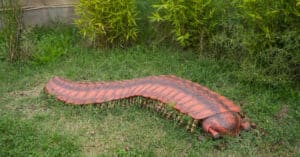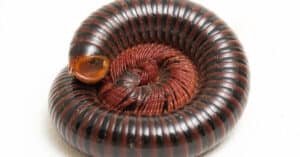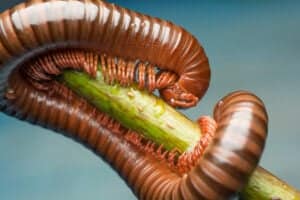Giant African millipedes can make great pets for beginners. If you are looking for an exotic species to keep that is easy to care for, then this creature may be perfect. Millipedes can have various sizes and colors. They are arthropods best known for their large number of legs. There are over 7,000 species of millipede in the world, and the giant African millipede is one of the largest. There are different species that can be classified as giant African millipedes.
Learning about the giant African Millipede can help you decide if it would be a great pet for you. They are simple to care for and have a certain wow factor to them. Small millipedes can be kept as pets, but giant African millipedes are more popular. Caring for them is effortless, and if done properly, they can have a lifespan of years. Before committing to this type of pet, learn everything they have to offer.
About Giant African Millipedes
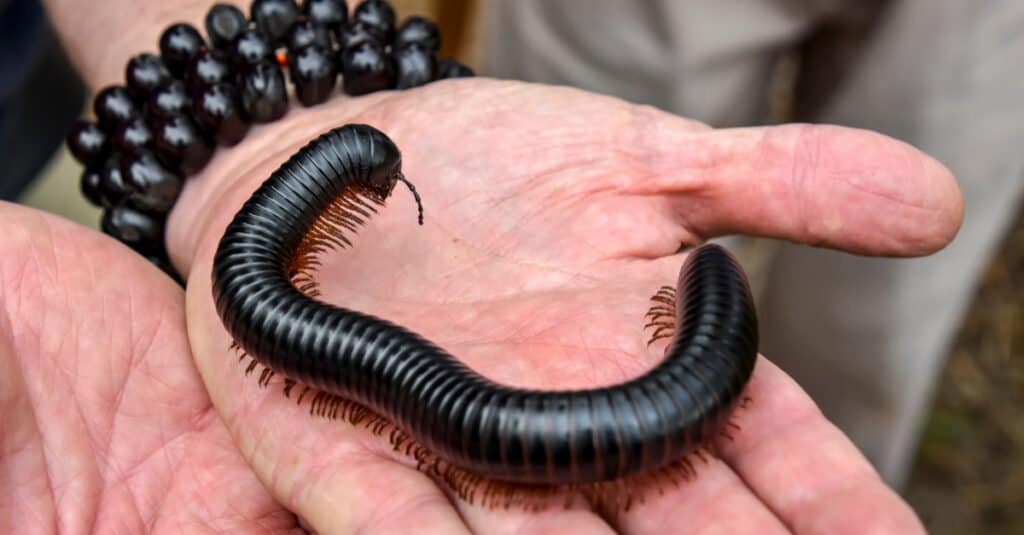
Giant African millipedes can be up to 15 inches long.
©Wandel Guides/Shutterstock.com
The largest species of millipede can be found in Africa. The African giant black millipede (Archispirostreptus gigas) is dark brown to black and capable of reaching 15 inches long. It is native to East Africa and one of the most sought species of millipede to own. Other African millipedes can also make great pets.
The Giant African millipede (Spiropoeus fischeri) is similar to the giant black millipede but smaller. This species is thought to be a better pet because it is more active and easier to handle. Another giant millipede living in Africa is the Ghana Chocolate millipede. Deciding on what species you would like is up to you.
Housing Giant Millipedes
Millipedes need the right environment to stay healthy and live longer. To create a proper habitat, a terrarium could replicate their natural environment. All millipedes need ample moisture and the appropriate substrate. A five to ten-gallon tank is better for providing large species enough space. Millipedes do not need to climb, so a wide tank is better than a tall one. Using a mesh top will give them oxygen and keep them from escaping.
The container they live in should have a substrate floor and can be filled with rocks, logs, and other debris. They will use the debris to hide and makes them more comfortable. Heavy light in their habitat is not recommended, as they prefer living in darker places. With the proper environment, any millipede species can be content. Most millipedes live in tropical environments, and their space should represent that. Their home should be cleaned weekly of old food or waste to keep it maintained.
What Do Giant Millipedes Eat?
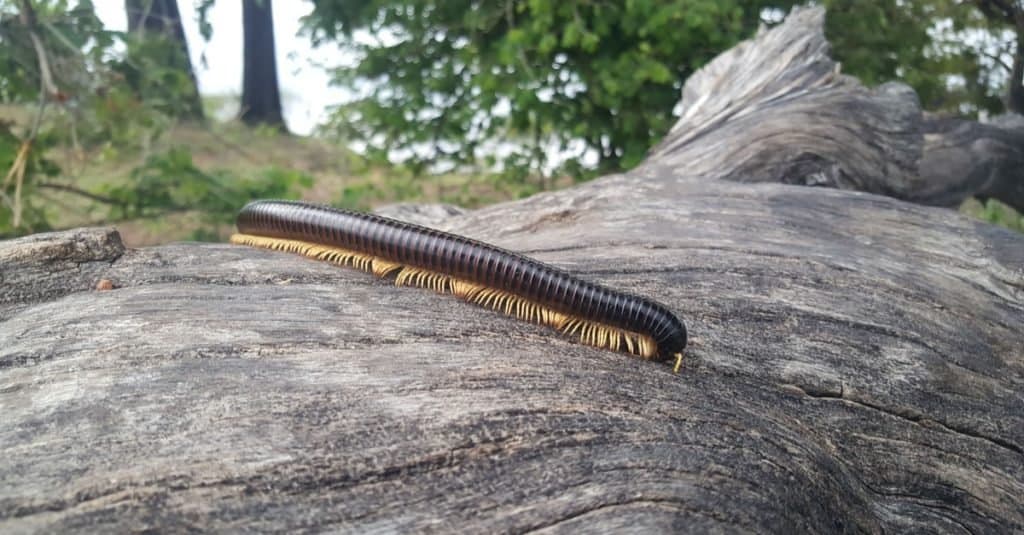
The Giant African millipede feeds on decaying plant material.
©Travel Telly/Shutterstock.com
Feeding your pet millipede is important in keeping it healthy. Millipedes are herbivores and will feed on dead and decaying organisms. They should be fed once a day and have a water dish to stay hydrated.
Some foods millipedes can eat include:
- Lettuce
- Melons
- Apples
- Cucumber
- Rotting leaves and wood
- Mushrooms
Millipedes should be fed cuttlebones that can be purchased at a pet store. This helps them maintain a healthy level of calcium in their bodies. Other foods and treats are available online, in your home, or at a pet shop. When food is not being eaten, it should be taken out at the end of the day.
Pros Of Owning And Cons Of Owning African Millipede
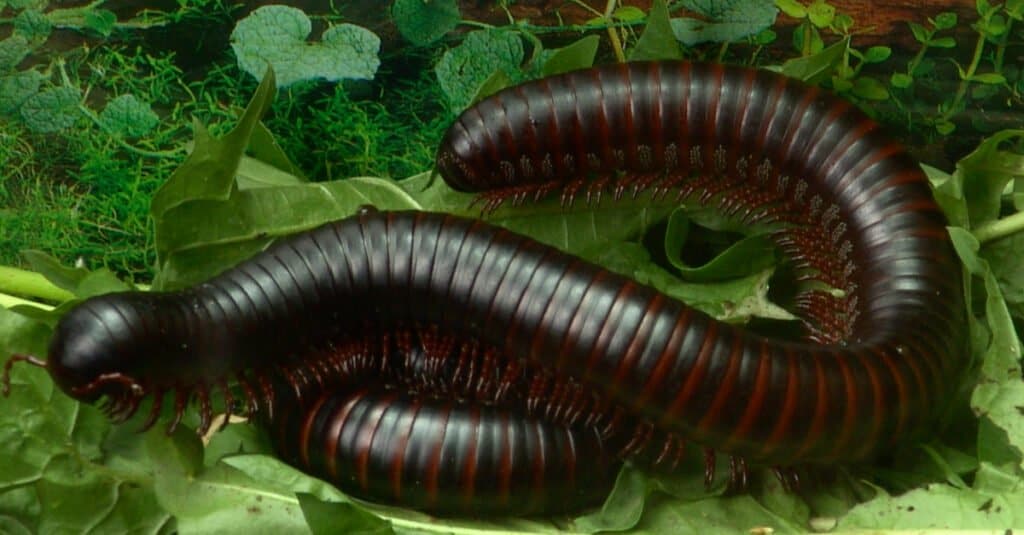
The Giant African Millipede requires minimal maintenance.
©skifbook/Shutterstock.com
One of the best reasons to get an African millipede is that they are an easy pet for beginners. You do not have to be an expert to care for and give this pet a long life. It requires minimal maintenance and fewer expenses when compared with other creatures. Millipedes are good showcase species and can wow guests.
Owning a millipede does have some issues, and everything should be considered before getting one as a pet. Millipedes are not dangerous but capable of secreting a toxin from their surface. They will do this when threatened. The toxin is often harmless but can lead to rashes, blistering and burning. If allergic to this substance, you may experience a more severe reaction and need medical attention. It is rare, but some millipedes can get unwell and die. Be prepared for anything when looking to own a millipede.
Having a giant millipede is great for bringing an exotic species into your home. The African giant millipede is one of the best for beginners and is also one of the largest. Learn everything about what these exotic creatures can offer. Some giant millipedes exist in other places like the U.S or Asia.
Different Types of Giant Millipedes That Can Make Great Pets
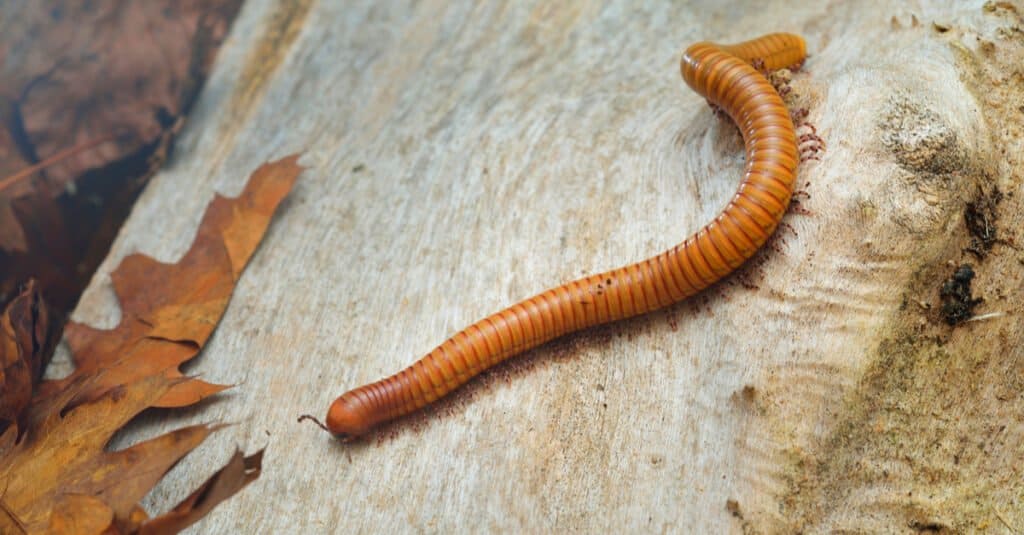
The Sonoran Desert millipede is also an excellent pet choice.
©Alex Stemmers/Shutterstock.com
With so many millipede species, many are classified as giant. Some millipedes are harder to find since the importation of non-native species is illegal in some places. Millipedes are adaptable and can become invasive if they are allowed to. In the U.S, non-native species can be owned but only obtainable through breeding. In countries like Canada, it is illegal to have a non-native millipede. Look at your local laws to find the best option.
Below are other giant millipedes that can make great pets:
- Thai Rainbow Millipede
- Flame Leg Millipede
- Sonoran Desert Millipede
- BumbleBee Millipede
- Ivory Millipede
- North American Giant Millipede
These species can be found in North America or Asia. The giant African millipede is one of the largest species in the world, but these listed millipede species are capable of growing up to 4 inches long. Their colors, size, and needs vary. Millipedes are easy to care for, beautiful to look at, and can make an excellent pet for many years if you treat them well.
The photo featured at the top of this post is © Wandel Guides/Shutterstock.com
Thank you for reading! Have some feedback for us? Contact the AZ Animals editorial team.



